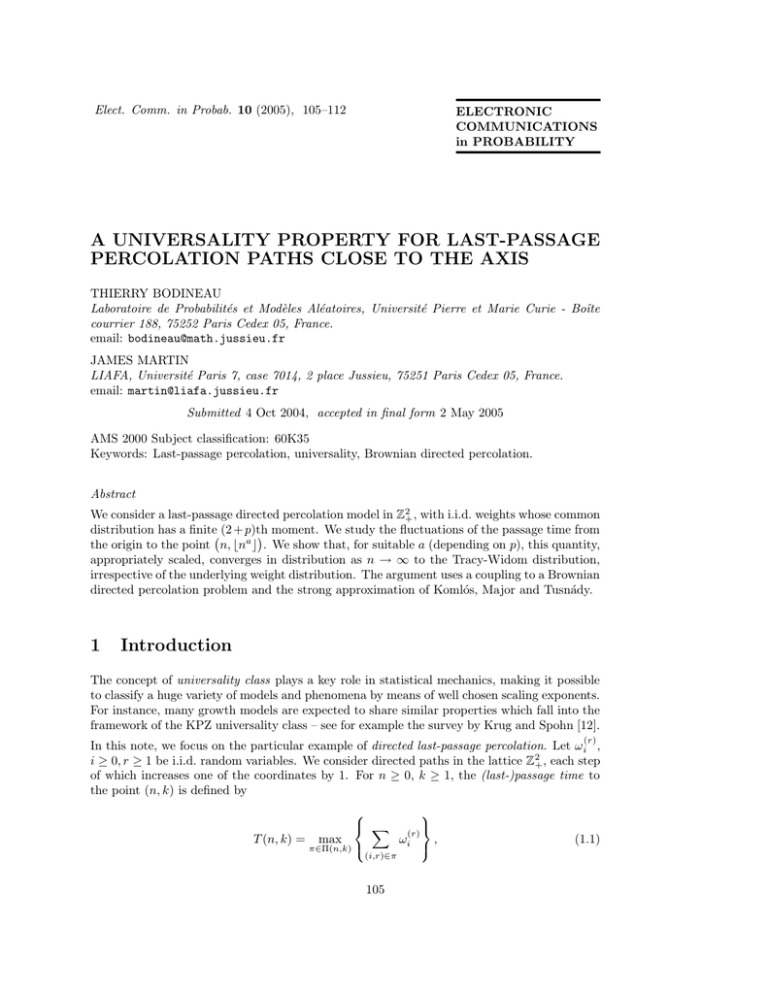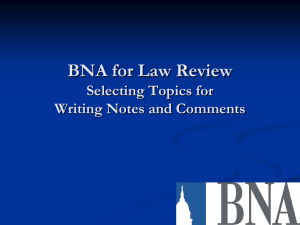A UNIVERSALITY PROPERTY FOR LAST-PASSAGE PERCOLATION PATHS CLOSE TO THE AXIS
advertisement

Elect. Comm. in Probab. 10 (2005), 105–112
ELECTRONIC
COMMUNICATIONS
in PROBABILITY
A UNIVERSALITY PROPERTY FOR LAST-PASSAGE
PERCOLATION PATHS CLOSE TO THE AXIS
THIERRY BODINEAU
Laboratoire de Probabilités et Modèles Aléatoires, Université Pierre et Marie Curie - Boı̂te
courrier 188, 75252 Paris Cedex 05, France.
email: bodineau@math.jussieu.fr
JAMES MARTIN
LIAFA, Université Paris 7, case 7014, 2 place Jussieu, 75251 Paris Cedex 05, France.
email: martin@liafa.jussieu.fr
Submitted 4 Oct 2004, accepted in final form 2 May 2005
AMS 2000 Subject classification: 60K35
Keywords: Last-passage percolation, universality, Brownian directed percolation.
Abstract
We consider a last-passage directed percolation model in Z2+ , with i.i.d. weights whose common
distribution has a finite¡ (2 + p)th
¢ moment. We study the fluctuations of the passage time from
the origin to the point n, bna c . We show that, for suitable a (depending on p), this quantity,
appropriately scaled, converges in distribution as n → ∞ to the Tracy-Widom distribution,
irrespective of the underlying weight distribution. The argument uses a coupling to a Brownian
directed percolation problem and the strong approximation of Komlós, Major and Tusnády.
1
Introduction
The concept of universality class plays a key role in statistical mechanics, making it possible
to classify a huge variety of models and phenomena by means of well chosen scaling exponents.
For instance, many growth models are expected to share similar properties which fall into the
framework of the KPZ universality class – see for example the survey by Krug and Spohn [12].
(r)
In this note, we focus on the particular example of directed last-passage percolation. Let ω i ,
i ≥ 0, r ≥ 1 be i.i.d. random variables. We consider directed paths in the lattice Z 2+ , each step
of which increases one of the coordinates by 1. For n ≥ 0, k ≥ 1, the (last-)passage time to
the point (n, k) is defined by
T (n, k) =
max
X
π∈Π(n,k)
(i,r)∈π
105
(r)
ωi
,
(1.1)
106
Electronic Communications in Probability
where Π(n, k) is the set of directed paths from (0, 1) to (n, k). More precisely,
Π(n, k) =
(
¡ ¢n+k
: z1 = (0, 1), zn+k = (n, k),
(z1 , z2 , . . . , zn+k ) ∈ Z2+
)
zj+1 − zj ∈ {(0, 1), (1, 0)} for 1 ≤ j ≤ n + k − 1 .
When the underlying weight distribution is exponential or geometric, scaling exponents for
this model are rigorously known. The deviation from a straight line of the optimal path to
the point (n, n) is of the order n2/3 (corresponding to the exponent ξ = 2/3) [3, 10], while the
fluctuations of the passage time T (n, n) are of the order n1/3 (corresponding to the exponent
χ = 1/3). In fact, one can give much more precise information: for the exponential distribution
with mean 1, say, it is shown in [9] that
£
¤
n−1/3 T (n, n) − 4n → FTW ,
(1.2)
where FTW is the “Tracy-Widom” distribution, which also appears as the asymptotic distribution of the largest eigenvalue of a GUE random matrix. It is expected (but not yet proved)
that the same scaling exponents, and indeed the same asymptotic distribution in (1.2), should
hold for a wide class of underlying weight distributions.
In this note we give a universality result for the quantities T (n, bna c) for a < 1. Thus, we are
concerned with passage times to points which are asymptotically rather close to the horizontal
axis, for a general class of underlying weight distribution. Our result is the following:
(r)
(r)
(r)
Theorem 1 Suppose that E |ωi |p³< ∞ ´
for some p > 2, with µ = E ωi , σ 2 = Var(ωi ).
Then for all a such that 0 < a < 76 21 − p1 ,
T (n, bna c) − nµ − 2σ n
1
a
σn 2 − 6
1+a
2
→ FTW
(1.3)
in distribution. In particular, if the weight distribution has finite moments of all orders, then
(1.3) holds for all a ∈ (0, 3/7).
Heuristically the theorem can be understood as follows. As the optimal path goes from the
origin to (n, bna c), one can imagine that between each step upwards, the path typically takes
on the order of n1−a steps to the right. Thus it should behave as the optimal path from the
origin to (na , na ) in a last percolation model with Gaussian weights of variance n1−a . On the
renormalized scale the expected fluctuations are of order (na )1/3 . In this way, we recover the
fluctuation exponent
1 a
1−a a
+ = − .
χ̂ =
2
3
2 6
This heuristic is made precise by coupling the discrete model with a Brownian directed percolation model for which the fluctuations have been explicitly computed. This is done using
the strong approximation of a random walk by a Brownian motion due to Komlós, Major
and Tusnády. (We note that this strong approximation has already been applied to similar
last-passage percolation models by Glynn and Whitt [7]).
A different sort of universality result for paths near the axis in directed percolation models
is given in [15]. By subadditivity, one has the convergence n−1 T (n, bxnc) → γ(x) a.s. and
Universality in last-passage percolation
107
in L1 , √
for some
√ function γ. Under the hypothesis of Theorem 1, it’s shown that γ(x) =
µ + 2σ x + o( x) as x ↓ 0.
The proof of Theorem 1 is given in the next section. In Section 3, we make some comments
on related models and possible extensions.
2
Fluctuations of the passage-time
(r)
We first introduce the Brownian directed percolation model. Let Bt , t ≥ 0, r ≥ 1 be a
sequence of independent standard Brownian motions. For t > 0, k ≥ 1, define
©
ª
U(t, k) = (u0 , u1 , . . . , uk ) ∈ Rk+1 : 0 = u0 ≤ u1 ≤ · · · ≤ uk = t ,
and then let
L(t, k) =
sup
k h
X
u∈U (t,k) r=1
i
(r)
.
−
B
Bu(r)
u
r−1
r
(2.1)
One can rewrite the definition of T (n, k) at (1.1) in an analogous way:
T (n, k) =
sup
k h
i
X
(r)
(r)
Sbur c+1 − Sbur−1 c ,
(2.2)
u∈U (n,k) r=1
Pm−1 (r)
(r)
where Sm = i=0 ωi .
The random variable L(1, k) has the same distribution as the largest eigenvalue of a k × k
GUE random matrix [5], [8], [17]. Hence in particular (e.g. [18])
√ ¤
£
k 1/6 L(1, k) − 2 k → FTW
in distribution, where FTW is the Tracy-Widom distribution.
√
By Brownian scaling, L(t, k) has the same distribution as tL(1, k). Using this we get, for
any 0 < a ≤ 1,
1+a
L (n, bna c) − 2n 2
→ FTW
(2.3)
a
1
n2−6
in distribution.
Theorem 1 says that the same distributional limit as in (2.3) (in particular, with the same
order of fluctuations) occurs for the law of T (n, bna c), for a general underlying distribution
(r)
of the weights ωi , if a is sufficiently small. We will use the following strong approximation
result, which combines Theorem 2 of Major [13] and Theorem 4 of Komlós, Major and Tusnády
[11]:
Proposition 2 Suppose ωi , i = 1, 2, . . . are i.i.d. with
Pm−1
E ωi = 0, Var(ωi ) = 1. Let Sm = i=0 ωi , m ≥ 1.
Then there is a constant C such that for all n > 0,
of (ω1 , . . . , ωn ) and a standard Brownian motion Bt ,
[n1/p , n1/2 ],
µ
P
max
m=1,2,...,n+1
E |ωi |p < ∞ for some p > 2, and with
there is a coupling of the distribution
0 ≤ t ≤ n + 1 such that, for all x ∈
|Bm − Sm | > x
¶
≤ Cnx−p .
(2.4)
108
Electronic Communications in Probability
Proof of Theorem 1:
We may assume that µ = 0 and σ 2 = 1, so that we need to prove that
T (n, bna c) − 2n
1
1+a
2
→ FTW
a
n2−6
(2.5)
in distribution (for general µ and σ 2 , one can obtain (1.3) from (2.5) after replacing ω by
(ω − µ)/σ).
¡ (r) ¢
(r)
If (ωi )i,r and Bt t,r are all defined on the same probability space, then from (2.1) and
(2.2) we get
|T (n, bna c) − L(n, bna c)|
¯
¯
¯
bna c ³
bna c ³
´
´¯¯
X
X
¯
(r)
(r)
(r)
(r)
¯
sup
sup
Bu0r − Bu0
Sbur c+1 − Sbur−1 c −
= ¯¯
r−1 ¯
u0 ∈U (n,bna c) r=1
¯
¯u∈U (n,bna c) r=1
( bna c
¯ ¯
¯
X ¯¯ (r)
¯ ¯ (r)
¯
(r)
(r)
≤
sup
¯Sbur c+1 − Bbur c+1 ¯ + ¯Sbur−1 c − Bbur−1 c ¯
u∈U (n,bna c)
r=1
¯
¯ ¯
¯
¯ ¯ (r)
¯ (r)
(r) ¯
−
B
+
+ ¯Bbur c+1 − Bu(r)
¯B
¯
ur−1 ¯
bur−1 c
r
bna c
X
)
(2.6)
¯
¯
¯
¯
¯ (r)
¯
(r) ¯
(r) ¯
≤2
max
sup ¯Bs(r) − Bt ¯
¯Si − Bi ¯ +
i=1,2,...,n+1
0≤s,t≤n+1
r=1
|s−t|<2
a
=2
bn c n
X
r=1
o
Vn(r) + Wn(r) ,
where we have defined
Vn(r) =
max
i=1,2,...,n+1
¯
¯
¯ (r)
(r) ¯
¯Si − Bi ¯ and Wn(r) =
sup
0≤s,t≤n+1
|s−t|<2
¯
¯
¯ (r)
(r) ¯
¯B s − B t ¯ .
³
´
(r)
(r)
(r)
(r)
For each r = 1, . . . , bna c we will couple ω0 , ω1 , . . . , ωn
and Bt , 0 ≤ t ≤ n + 1 as in
(r)
Proposition 2, maintaining the independence for different r, so that the V n , 1 ≤ r ≤ bna c
are i.i.d. with
³
´
(2.7)
P Vn(r) > x ≤ Cnx−p
£
¤
for all x ∈ n1/p , n1/2 .
n
o
(r)
Let A1 be the event max1≤r≤bna c Vn > n1/2 . Then from (2.7),
P(A1 ) ≤ na Cn(n1/2 )−p = Cna+1−p/2 → 0 as n → ∞,
since by assumption a <
6
7
³
1
2
−
1
p
´
<p
³
1
2
−
1
p
´
=
p
2
− 1.
(2.8)
Universality in last-passage percolation
109
n
o
(r)
Also let A2 be the event max1≤r≤bna c Wn > n1/p . Using the reflection principle and
standard estimates on the normal distribution,
¯
¯
¯
(1) ¯
P(A2 ) ≤ na P sup ¯Bs(1) − Bt ¯ > n1/p
0≤s,t≤n+1
|s−t|<2
n−2
X
≤n
a
≤n
a+1
P
i=0
P
µ
µ
sup Bt −
i≤t≤i+3
sup |Bt | > n
inf
i≤t≤i+3
1/p
/2
0≤t≤3
³
´
Bt > n
1/p
¶
¶
= 4na+1 P B3 > n1/p /2
´
³
≤ c1 na+1 exp −c2 n2/p
→ 0 as n → ∞.
(2.9)
From (2.6), (2.7) and the definitions of the events A1 and A2 , we have
h
i
C
E |T (n, bna c) − L(n, bna c)| ; AC
1 ∪ A2
´
³
C
∪
A
≤ 2na E Vn(1) + Wn(1) ; AC
2
1
h
³
´
i
≤ 2na n1/p + E Vn(1) − n1/p ; n1/p ≤ Vn(1) ≤ n1/2 + n1/p
Ã
!
Z n1/2 ³
´
≤ 2na 2n1/p +
P Vn(1) > x dx
n1/p
≤ 2na
Ã
n1/p +
Z
n1/2
Cnx−p dx
n1/p
!
(2.10)
´
³
1/2
= 2na n1/p + C2 n[−x−p+1 ]nn1/p
≤ C3 na n1/p ,
where C2 and C3 are constants independent of n.
Together with (2.8) and (2.9), this gives that, for any ² > 0,
´
³
P |T (n, bna c) − L(n, bna c)| > na+1/p+² → 0 as n → ∞.
The assumption a <
6
7
³
1
2
−
1
p
´
implies that, for ² sufficiently small, a +
|T (n, bna c) − L(n, bna c)|
1
a
n2−6
Using (2.3) we obtain (2.5) as desired.
1
p
+²<
→ 0 in distribution, as n → ∞.
(2.11)
1
2
− a6 . Thus
(2.12)
¤
110
Electronic Communications in Probability
3
3.1
Further remarks
Larger values of a
It seems unlikely that the value 3/7 in Theorem 1 represents a real threshold. For a > 3/7,
consider the typical difference between the weight of the maximal Brownian path and the
weight of the discrete approximation; this will be large compared to the order of fluctuations
of the maximum. However, the standard deviation of this difference may be smaller; one
might expect it to be of order na/2 rather than order na , since it is composed of na terms of
constant order which one expects to become independent as n becomes large. An argument
along these lines would effectively allow us to replace na by na/2 in (2.10) leading to a bound
a < 3/4 rather than a < 3/7. However, above a = 3/4 it seems that the behaviour is genuinely
different and more sophisticated arguments would be required: the fluctuations of the error in
the discrete approximation to the Brownian path are likely to be larger than the fluctuations
of the maximal weight itself, and so one might no longer expect the maximal discrete path to
follow closely the maximal Brownian path (even when the weights are “strongly coupled” to
the Brownian motions as above).
3.2
Transverse fluctuations
The exponent χ̂ = 21 − a6 which we obtain should be related to the transversal fluctuations of
the optimal path away from the straight line {y = na−1 x}. Let us introduce the exponent
õ
¶ !
a 2
n
1
log E
.
vb n2 c −
ξˆ = lim
n→∞ 2 log n
2
where, say, vi is the smallest value r such that the point (i, r) is contained in the optimal path.
Corresponding to the universal value of χ̂ obtained, one would expect that ξˆ should be also
a universal exponent equal to 2a/3. To see this, we follow the heuristics explained in the
introduction. On a renormalized level, the optimal path should behave as the optimal path
from the origin to (na , na ) in a last percolation model with Gaussian weights. This would imply
that the transverse fluctuations should scale like (na )2/3 , where ξ = 2/3 is the (predicted)
standard fluctuation exponent for directed last-passage percolation.
The strategy used in [10] for the derivation of the transverse fluctuations requires not only
the knowledge of the last passage time fluctuations, but also a precise control of the moderate
deviations. Our approach does not allow us to derive such sharp estimates (in particular we are
missing some uniformity with respect to the direction of the path). For this reason, we do not
yet have a proof of the universality of the transversal fluctuation exponent in our framework.
3.3
Related models
The last-passage percolation processes have a natural interpretation in terms of systems of
queues in tandem (see for example [1, 7, 14]). Considering paths near the axis corresponds to
considering regimes of very high or very low load in the queueing systems. In the case of exponential weight distribution, these queueing systems correspond closely to totally asymmetric
exclusion processes or totally asymmetric zero-range processes. There are also close links with
systems of non-colliding particles. See for example [16] for a survey.
Universality in last-passage percolation
Of course, there are also strong connections between these models and random matrix theory.
We mention one particular direction related to the topic of this paper. Let An,k be an n × k
random matrix with i.i.d. entries, and let Yn,k = An,k (An,k )∗ . In the special case of the
Laguerre ensemble, where the common distribution of the entries is complex Gaussian, one
has an explicit correspondence between the largest eigenvalue of Y and the passage time to
(n, k) in a directed percolation model with exponential weights (see for example Proposition
1.4 of [9], and [6] and Section 6.1 of [2] for extensions). For a general distribution, there may
not exist an explicit mapping between the matrix model and the directed percolation model,
but we believe that a similar averaging mechanism to that observed in our context will also
play a role in the random matrix setting. Thus on the basis of the analysis of the last passage
time fluctuations for paths close to the axis, we conjecture that when k and n tend to infinity
with suitable rates, the fluctuations of the largest eigenvalue of Yn,k should depend only on
the mean and the variance of the coefficients of An,k .
Note
Related results have recently been obtained independently by Baik and Suidan [4]. Their methods also involve a coupling to a Brownian directed percolation problem, but via a Skorohod
embedding technique rather than the strong approximation used here.
Acknowledgments
We thank Giambattista Giacomin, Yueyun Hu, Neil O’Connell and Gérard Ben Arous for
valuable discussions, and Patrik Ferrari for helpful comments.
References
[1] Baccelli, F., Borovkov, A. and Mairesse, J., (2000) Asymptotic results on infinite
tandem queueing networks. Probab. Theory Related Fields 118, 365–405.
[2] Baik, J., Ben Arous, G. and Péché, S., (2004). Phase transition of the largest
eigenvalue for non-null sample covariance matrices. Preprint math.PR/0403022.
[3] Baik, J., Deift, P., McLaughlin, K. T.-R., Miller, P. and Zhou, X., (2001)
Optimal tail estimates for directed last passage site percolation with geometric random
variables. Adv. Theor. Math. Phys. 5, 1207–1250.
[4] Baik, J. and Suidan, T., (2005) A GUE central limit theorem and universality of
directed first and last passage site percolation. Int. Math. Res. Not. 2005, no. 6, 325–
337.
[5] Baryshnikov, Y., (2001) GUEs and queues. Probab. Theory Related Fields 119, 256–
274.
[6] Doumerc, Y., (2003) A note on representations of eigenvalues of classical Gaussian
matrices. In Séminaire de Probabilités XXXVII, vol. 1832 of Lecture Notes in Math.,
pages 370–384. Springer, Berlin.
[7] Glynn, P. W. and Whitt, W., (1991) Departures from many queues in series. Ann.
Appl. Probab. 1, 546–572.
111
112
Electronic Communications in Probability
[8] Gravner, J., Tracy, C. A. and Widom, H., (2001) Limit theorems for height fluctuations in a class of discrete space and time growth models. J. Statist. Phys. 102,
1085–1132.
[9] Johansson, K., (2000) Shape fluctuations and random matrices. Comm. Math. Phys.
209, 437–476.
[10] Johansson, K., (2000) Transversal fluctuations for increasing subsequences on the plane.
Probab. Theory Related Fields 116, 445–456.
[11] Komlós, J., Major, P. and Tusnády, G., (1976) An approximation of partial sums
of independent RV’s, and the sample DF. II. Z. Wahrscheinlichkeitstheorie und Verw.
Gebiete 34, 33–58.
[12] Krug, J. and Spohn, H., (1992) Kinetic roughening of growing surfaces. In C. Godrèche,
ed., Solids far from equilibrium, Collection Aléa-Saclay: Monographs and Texts in Statistical Physics, 1, pages 479–582. Cambridge University Press, Cambridge.
[13] Major, P., (1976) The approximation of partial sums of independent RV’s.
Wahrscheinlichkeitstheorie und Verw. Gebiete 35, 213–220.
Z.
[14] Martin, J. B., (2002) Large tandem queueing networks with blocking. Queueing Syst.
Theory Appl. 41, 45–72.
[15] Martin, J. B., (2004) Limiting shape for directed percolation models. Ann. Probab. 32,
2908–2937.
[16] O’Connell, N., (2003) Random matrices, non-colliding particle systems and queues.
In Séminaire de Probabilités XXXVI, no. 1801 in Lecture Notes in Mathematics, pages
165–182. Springer-Verlag.
[17] O’Connell, N. and Yor, M., (2002) A representation for non-colliding random walks.
Electron. Comm. Probab. 7, 1–12 (electronic).
[18] Tracy, C. A. and Widom, H., (2002) Distribution functions for largest eigenvalues
and their applications. In Proceedings of the International Congress of Mathematicians,
Vol. I (Beijing, 2002), pages 587–596. Higher Ed. Press, Beijing.




